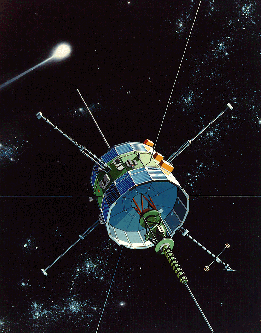|
|
ISEE-3/ICE

The International Sun-Earth Explorer (ISEE) program consisted of 3
satellites-- ISEE-1 and ISEE-3 were the principal US contribution to the
International Magnetospheric Study, and ISEE-2 which was built and managed by
ESA. ISEE-1 and -2 were launched on 22 October 1977 into almost coincident
orbits. The orbital period was 57 hours, and their separation in the orbit was
controlled by manuvuering ISEE-2. ISEE-3 was launched on 12 August 1978. It
was inserted into a "halo" orbit about the libration point some 240
Earth radii upstream between the Earth and Sun. ISEE-3 was renamed ICE
(International Cometary Explorer) when, after completing its original mission
in 1982, it was gravitationally manuvuered to intercept the comet
P/Giacobini-Zinner. On September 11, 1985, the veteran NASA spacecraft flew
through the tail of the comet.
The ISEE-3/ICE bit rate was nominally 2048 b/s during the early part of the
mission and 1024 b/s during the P/Giacobini-Zinner encounter. The bit rate
then dropped to 512 b/s on 9/12/85, 256 b/s on 5/1/87, 128 b/s on 1/24/89,
and finally 64 b/s on 12/27/91. An extended ICE mission was approved by
NASA in 1991 for the continued investigation of coronal mass ejections,
continued cosmic ray studies, and coordinated observations with Ulysses. As
of January 1990, the satellite was in a 355 day heliocentric orbit with an
aphelion of 1.03 AU, perihelion of 0.93 AU, and inclination 0.1 degree. It
will return to the vicinity of the Earth-moon system in August 2014.
The University of California put an X-ray Spectrometer aboard ISEE-3. It
was designed to study both solar flares and cosmic gamma-ray bursts over
the energy range 5-228 keV. The detector provided full-time coverage, 3-pi
sr field of view for E > 130 keV, time resolution of 0.25 ms, and absolute
timing to within 1 ms. It was intended to be a part of a long baseline
interferometry network of widely separated spacecraft. The efforts were
aimed primarily at determining the origin of the bursts through precise
directional information established by such a network. The experiment
consisted of 2 cylindrical X-ray detectors: a Xenon filled proportional
counter covering 5-14 keV, and a NaI(Tl) scintillator covering 12-1250
keV. The proportional counter was 1.27 cm in diameter and was filled with a
mixture of 97% Xenon and 3% carbon dioxide. The central part of the counter
body was made of 0.51 mm thick beryllium and served as the X-ray entrance
window. The scintillator consisted of a 1.0 cm thick cylindrical shell of
NaI(Tl) crystal surrounded on all sides by 0.3 cm thick plastic
scintillator. The central region, 4.1 cm in diameter, was filled by a
quartz light pipe. The whole assembly was enclosed (except for one end) in
a 0.1 cm thick beryllium container. The energy channel resolution and timing
resolution could be selected by commands sent to the spacecraft. The
proportional counter could have up to 9 channels with 0.5 s resolution; the
NaI scintillator could have up to 16 channels and 0.00025 s resolution.
The gamma-ray burst mode was triggered by two simultaneous conditions: the
count rates in certain PHA channels rose above a selected level and the
spectral hardness of incident photons as determined by the ratio of 2
selected PHA channels exceeded a certain value.
Also aboard ISEE-3 was the Goddard Gamma-Ray Burst Spectrometer. This
instrument represented the first successful flight of a high purity
germanium detector on a satellite. It provided an order of magnitude
improvement in the measurement of spectral properties of gamma-ray bursts
than any previously flown detector.
The germanium detector was a high purity 4.02 x 2.9 cm right circular
cylinder. The total germanium volume was 35 cu-cm. The detector was
hermetically sealed in a Mg enclosure, which also provided the radiative
surface for cooling. This structure reached a temperature of 130K roughly 3
days after launch and remained stable at that value for over a year. The
detector system had a resolution of 10 keV at 570 keV and had 4096 energy
channels. It operated in the range 200 keV - 3 MeV. The nominal time
resolution was an 8 ms spectral data integration.
[Gallery]
[Publications]
[NSSDC ISEE-3 archive]
[All Missions]
[by Time]
[by Energy]
Page authors: Lorella Angelini Jesse Allen
HEASARC Home |
Observatories |
Archive |
Calibration |
Software |
Tools |
Students/Teachers/Public
Last modified: Monday, 10-May-2010 10:07:20 EDT
|


